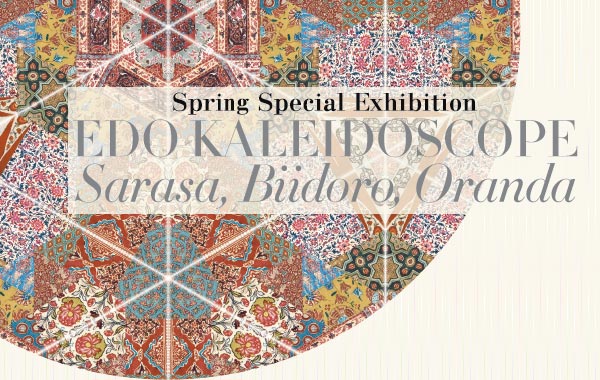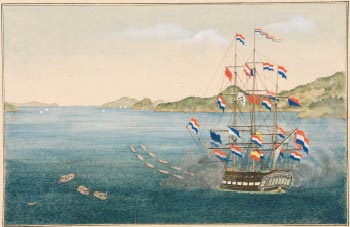 |
|
 |
 |
Japan’s contact with the outside world during the Edo period (1603–1867) was limited by its official seclusion policy, and yet a much greater variety of goods were imported from overseas than is often imagined. Among the goods transported on the ships of the Dutch East India Company, which were the main bridges between Japan and the West in that time, were handcrafted works that captured the hearts and the tastes of Japanese. Their fascination with these imports must have been something like the delight they experienced upon peering into one of the kaleidoscopes that were brought from Europe around the same time.
Of the diverse imports that arrived on Japan’s shores during the Edo period, this exhibit takes up craft products imported mainly by the Dutch East India Company: Indian sarasa, the cotton fabric that so fascinated people all over the world; European glass ware—called biidoro (from the Portuguese vidro) by Japanese—which would become the models for development of Japan’s own glass craft; and European ceramics, mainly the much prized Delft ware, which was called oranda. Our focus is on how these goods were enjoyed and used at the time. The imported fabric and vessels were themselves treasured but they were also incorporated into people’s lives in various ways. Sarasa was sewn onto garments and fashioned into various accessories; European works of glassware inspired Japanese artisans to study and deepen their own glassmaking craft; and Ogata Kenzan and other potters developed distinctive styles drawing hints from the imported Dutch pottery.
This exhibition presents a rare opportunity to appreciate the fabrics and vessels of these delicate craft genres that have been preserved and treasured with great care over several centuries. We hope the works on display will not only excite curiosity but nourish greater insight into the refined crafts in which they originated and the aesthetic taste of Japanese of those days. These treasures of sarasa, biidoro, and oranda show the selectiveness of the people of the Edo period in the things they imported and the great sensitivity with which they used them for the advancement of their culture.
Of the diverse imports that arrived on Japan’s shores during the Edo period, this exhibit takes up craft products imported mainly by the Dutch East India Company: Indian sarasa, the cotton fabric that so fascinated people all over the world; European glass ware—called biidoro (from the Portuguese vidro) by Japanese—which would become the models for development of Japan’s own glass craft; and European ceramics, mainly the much prized Delft ware, which was called oranda. Our focus is on how these goods were enjoyed and used at the time. The imported fabric and vessels were themselves treasured but they were also incorporated into people’s lives in various ways. Sarasa was sewn onto garments and fashioned into various accessories; European works of glassware inspired Japanese artisans to study and deepen their own glassmaking craft; and Ogata Kenzan and other potters developed distinctive styles drawing hints from the imported Dutch pottery.
This exhibition presents a rare opportunity to appreciate the fabrics and vessels of these delicate craft genres that have been preserved and treasured with great care over several centuries. We hope the works on display will not only excite curiosity but nourish greater insight into the refined crafts in which they originated and the aesthetic taste of Japanese of those days. These treasures of sarasa, biidoro, and oranda show the selectiveness of the people of the Edo period in the things they imported and the great sensitivity with which they used them for the advancement of their culture.
 |
Many rare goods were introduced to Japan through the trade activities of the Dutch East Indies Company, which used Hirado and Dejima as ports of entry. The Netherlands was the only country in Europe that was allowed to trade with Japan under the policy of national isolation.
|

Important Art Object Nagasaki Museum of History and Culture Exhibited from April 15 to May 11 |
|